Narvik War Museum presents the exhibition ‘The battle of Narvik – Facts vs Fiction’
The movie ‘The battle of Narvik’ is inspired by real events – the German attack on Norway in 1940 and the war that followed.
Some of the events of ‘The battle of Narvik’ never actually took place, and not all of the characters of the movie are real. Several historical events and persons are joined together to create a kind of order of a chaotic time. Nevertheless, the movie reflects events and happenings as experienced both by local population and soldiers in 1940.
The Narvik War and Peace Centre works with documentation, research, and education about the North Norwegian WW2 history. We have contributed with advice and input during the movie production. This exhibition contains our views on some of the choices made by the moviemakers. You will encounter a traffic light model:
![]() These are facts
These are facts
![]() This is fiction
This is fiction
![]() This is somewhere in between
This is somewhere in between
Welcome to the “The Battle of Narvik – Facts vs. Fiction” exhibition!
Historical photo: Narvik War Museum/ Imperial War Museum
Photos from the movie: Nordisk Film
Stills: Eirik Linder Aspeland/ Nordisk Film
Choose a box for more information

Gunnar Tofte arrives in his hometown Narvik as a neutrality guard. At the hotel the German and the British consuls listen to the mayor’s speech about the iron ore shipping.
April 8th a squad of Norwegian soldiers arrive in Narvik to reinforce the neutrality guard in the city.
![]()
Not until late evening, the district command ordered a reinforcement in Narvik. Most soldiers didn´t arrive until after midnight, numbering several hundred men.
——————–
At Royal Hotel there is still no official information about the British mining of the Norwegian coast. Narvik’s mayor requests that the British and German consuls make sure there is free passage for all ships in Norwegian waters.
![]()
The British did inform Norwegian authorities about the mining while they were doing it. Later in the day this violation of Norway’s neutrality was broadcast in radio and press. The tension April 8th was in reality far more pronounced than the opening scene shows.
——————–
Ingrid awakes to the sound of explosions.
![]()
Many of Narvik’s inhabitants were suddenly awakened when the first German torpedoes struck the Norwegian battle ships just after 4:30 in the morning April 9th.
——————–
Facts: Spring 1940
When the British laid mines in Vestfjorden on April 8th, the German battleships were already on their way north to invade Norway. It was by Narvik that the battles against the Norwegians and allied forces lasted the longest.
Klikk for større bilder
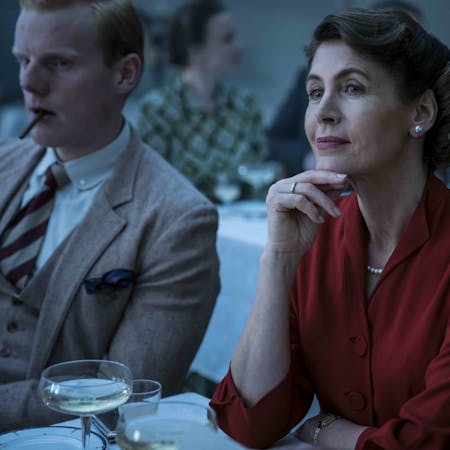
The British consul Ross in a conversation with "Polly"

Gunnar and his fellow soldiers on their way to Narvik on neutrality guard

The Major speaks to the consuls in Narvik April 8th

The Norwegian commander surrenders the city once the German general suggests a deal has already been agreed.
![]()
The military planners in Berlin knew colonel Sundlo was German-friendly. But there is no evidence to suggest he had agreed in advance to surrender Narvik.
——————–
The surrender of Narvik happens immediately during the first meeting of the Norwegian colonel and general Dietl.
![]()
As the Germans landed, there was, at first, an agreement of half an hour’s truce. The Germans took advantage to take up positions in the city, which made it far more difficult for the Norwegians to take up the fight.
——————–
Norwegian soldiers march out of the city right in front of German sentries.
![]()
A Norwegian unit of 200 men bluffed their way out of the city, and took up positions along the railway just outside of Narvik. They later withdrew further, towards the Norddal bridge, Bjørnfjell, and the Swedish border.
——————–
The Germans establish their headquarters at Royal Hotell.
![]()
In 1940, the hotels Royal and Grand were side by side. In the movie they are merged into what is apparently Narvik’s only hotel. General Dietl set up his first headquarters at Grand Hotel, not Royal. Grand Hotel burned down on May 9th.
——————–
Facts: April 9th
During the German attack, the two Norwegian battle ships Norge and Eidsvold went down with 282 men. The local commander, colonel Sundlo surrendered the town.
Klikk for større bilder

The major leads his men out of Narvik April 9th

Colonel Sundlo surrenders Narvik to General Dietl

The Germans take over the Royal Hotell

The Norwegian soldiers are about to blow up the Norddal bridge but are engaged by the enemy. Ingrid and Ole find themselves in a dangerous situation.
Norwegian soldiers attempt to blow up the Norddal bridge along the Ofoten rail way line between Narvik and the Swedish border.
![]()
Norwegian soldiers were ordered to blow up the Norddal bridge to prevent the Germans from taking control of the iron ore shipping. They only managed to damage the bridge. This happened on April 14th, meaning several days later than the same event in the movie.
——————–
Civilians appear in the tunnel entrance by the Norddal bridge. They have left a stopped train, and continued on foot along the tracks.
![]()
Right after the German invasion on April 9th, many people fled Narvik, including by train. However, on April 14th, during the preparations and attempted destruction of the Norddal bridge, there were no civilians nearby.
——————–
Norwegian soldiers are attacked, with several taken prisoner by the Germans.
![]()
There were no fights with German soldiers during the attempted destruction of the bridge. But two days later, on April 16th, the Germans attacked Bjørnfjell and took several prisoners of war (POWs). After this, they controlled the whole railway line until the Allied reconquest of Narvik.
——————–
Facts: April 10th – 14th
The British Navy sank all the German battleships in the Ofoten fjord in two sea battles. The German forces on land were isolated and were stopped in their attempt to advance further north.
Klikk for større bilder

Gunnar is assigned the task to attach the dynamite on the Norddal bridge

Norwegian soldiers are taken prisoners
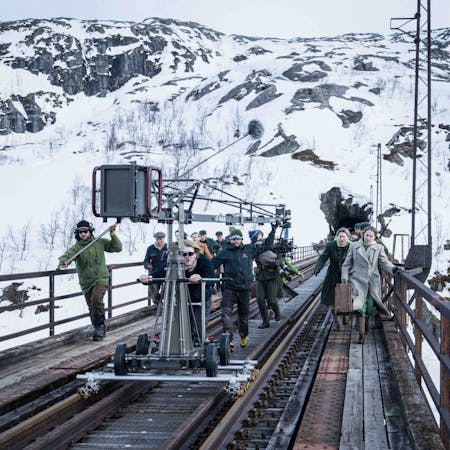
Civilians appear in the tunnel entrance (from the film recording of the movie)

From the hotel in Narvik, Ingrid witnesses the British navy’s attack. “Polly” informs that all the German war ships have been destroyed.
![]()
There were two naval battles between British and German ships in the days after the invasion. In the first battle, some of the German ships were taken out. But after the second, all German ships were destroyed. Both battles took place before the attempted destruction of the Norddal bridge.
——————–
People are expecting the British to come ashore.
![]()
After the battles at sea, there were great expectations among the city’s population of a British landing. Therefore, disappointment was equally great when this did not materialise.
——————–
The continuous British bombardment of Narvik makes Ingrid despair.
![]()
The British ships controlled the seas, and often fired at suspicious movements and targets in and around Narvik. The bombardment was not on a daily basis, but several civilians perished as a result of it. There was a widespread bitterness among the Narvik population over the Allied tactic in April and May.
——————–
Consul Wussow shows Ingrid a list of Norwegian soldiers who have been taken prisoner or are presumed dead.
![]()
As per the film, this list contains prisoners who were taken by the Norddal bridge. But this event is fictional and not based on real events. The list also consists of real and fictitious names.
——————–
Facts: April 14th – 24th
The allied forces established its headquarters in Harstad. On April 16th the Germans took control of the Ofot Railway, and placed a line of defence to the north and south of Narvik. The Norwegians mobilised for a counter attack
Klikk for større bilder

The British attack German ships in Narvik harbor
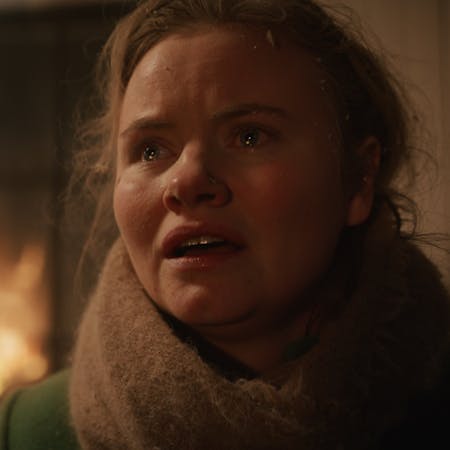
Family Tofte´s house is hit by Allied grenades
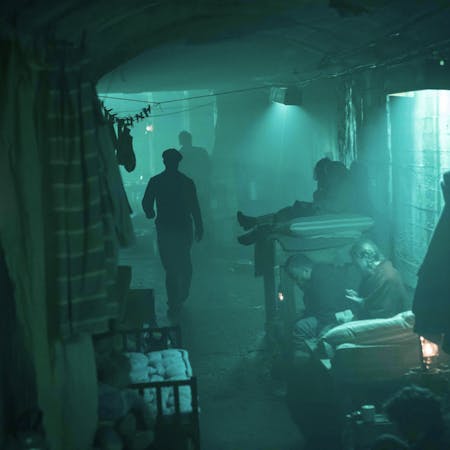
Civilians seeked refuge in the Bolagstunnel (the tunnel under the ironore company LKAB)

Norwegian POWs are put to transport ammunition to German positions in the mountains.
![]()
The Germans forced the Norwegian POWs to carry supplies to the front line in the mountains. Clearing snow and debris from blasts were other tasks given.
——————–
French soldiers arrive to clear the German positions on the Roasme mountain.
![]()
Norwegian troops themselves cleared Roasme of Germans on May 7th. The cooperation between Norwegian and Allied troops was not very coordinated, and with few exceptions, they also did not fight side by side.
——————–
Gunnar despairs when he finds a photo of a wife and child in the pocket of a dying German soldier. He exclaims: “What the (….) are you doing here?”
![]()
The scene is inspired by a Norwegian soldier’s personal story, who saw a German soldier’s wedding ring, not a photo.
——————–
The good weather.
![]()
On May 7th there were clear skies in the area, as the battle scenes of Roasme also show. The fighting in the mountains were generally characterised by challenging and fast changing weather conditions. Ice cold gusts, whipping rain, fog, and vast amounts of snow, were just some of the hardships the soldiers had to endure.
——————–
Facts: April – May
The North Norwegian forces started a counter attack from the north. French and Polish troops arrived at the front. Narvik lost value for the allied forces after the German attack on France on May 10th.
Klikk for større bilder

A dying German soldier carries a photo of his family

Norwegian and French soldiers fight together in the mountains

Norwegian prisoners of war are forced to work for the Germans

Norwegian and French troops storm forward together after the landing.
![]()
The first attack wave of the reconquest consisted of French soldiers. They established a position at Orneset, northeast of Narvik. A Norwegian unit followed, and advanced in the steep terrain.
——————–
Norwegian and French troops spread and flee back towards the sea.
![]()
No one knows for sure what happened, and the reports vary. Some say that both Norwegian and French troops panicked when the Germans mounted a surprising counterattack. The officers in charge managed to rally the troops again and reorganise.
——————–
The Germans use artillery mounted onto an armoured railcarriage, which is shifted in and out of the tunnel opening above Orneset.
![]()
Such artillery was used to return Norwegian and Allied artillery. But the Germans had limited ammunition and could not benefit fully from this weapon.
——————–
Gunnar, Hansen, and a French soldier carry out an ambush.
![]()
The shooting scene and explosion in the tunnel are fictitious. In reality, three Norwegian soldiers made an evasive manoeuvre while signalling to the British ships where the most dangerous German positions were. This contributed to the decisive breakthrough.
——————–
Facts: May 28 th
The allied forces decided to recapture Narvik before they left Norway. French and Norwegian soldiers attacked across the fjord from the north east and the Polish from the south. The Germans withdrew from the town up towards the mountains by the border.
Klikk for større bilder

Gunnar is given a key role in the reconquest of Narvik

The reconquest becomes dramatic

The Norwegian flag is raised again above Narvik

Narvik is bombed by German planes.
![]()
The Germans laid Narvik in ruins through fierce air raids around the turn of May/June. On May 31st, several blocks burned to the ground, killing one and injuring three. On June 2nd, nearly 100 buildings in Oscarsborg burned down, and three people perished when the theatre building caught fire. Several wounded were taken to hospital.
——————–
The civilian population are evacuated by fishing boats.
![]()
In just a few days, 3500 inhabitants were evacuated from Narvik with the help of a large number of fishing boats. Just a few dozen people were left in the city until the fighting ended.
——————–
One of the Norwegian soldiers dies by a German bomb explosion, and the rest of the men are incited to one last push by the officer.
![]()
On June 2nd, a Norwegian soldier was killed by a German bomb. But the Norwegian troops’ demonstrated a strong will and determination to catch and defeat the Germans after the reconquest.
——————–
Facts: May 29th – June 10th
German bomber planes laid Narvik in ruins and a large number of forces closed in from the south. The Norwegian soldiers had to surrender their weapons on 8 June. A capitulation contract was signed two days later.
Klikk for større bilder
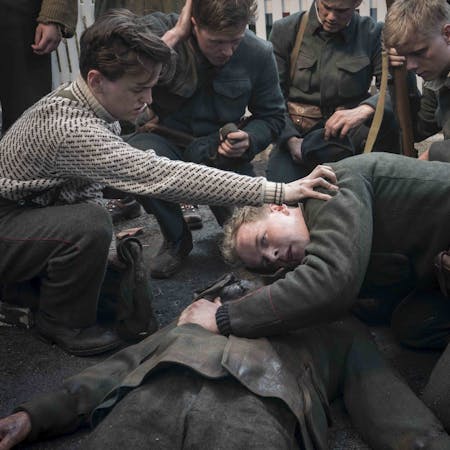
A soldier is killed by German bombs

Gunnar is in doubts

Civilians are getting ready to be evacuated (from the filming)